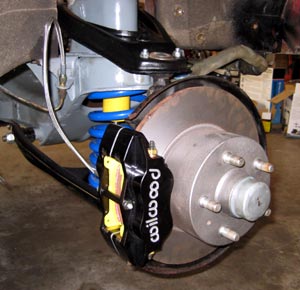Handling
 Classic Volvos were designed back when Swedish roads were largely gravel, so they are sprung fairly softly for comfort and sit fairly high for ground clearance. With the original tires, the cars were well-balanced and predictable near their limits, but those limits happen at modest speeds by modern standards. Modern tires - even skinny ones in the stock sizes - produce much more traction than the original ones, and this actually makes the problem worse. The added grip allows more body roll before the tires start to slide, and the extra amount of roll exceeds what the suspension geometry was designed to cope with. The result is handling that's not as well-mannered or predictable as it once was. Fortunately, some excellent products are available from a number of suppliers to correct this. An old Volvo can be made to handle extremely well by installing the appropriate upgrades. There's no magic combination of these parts that will suit different models, drivers, or road conditions, though, so some common sense backed by experience goes a long way towards achieving optimum results.
Classic Volvos were designed back when Swedish roads were largely gravel, so they are sprung fairly softly for comfort and sit fairly high for ground clearance. With the original tires, the cars were well-balanced and predictable near their limits, but those limits happen at modest speeds by modern standards. Modern tires - even skinny ones in the stock sizes - produce much more traction than the original ones, and this actually makes the problem worse. The added grip allows more body roll before the tires start to slide, and the extra amount of roll exceeds what the suspension geometry was designed to cope with. The result is handling that's not as well-mannered or predictable as it once was. Fortunately, some excellent products are available from a number of suppliers to correct this. An old Volvo can be made to handle extremely well by installing the appropriate upgrades. There's no magic combination of these parts that will suit different models, drivers, or road conditions, though, so some common sense backed by experience goes a long way towards achieving optimum results.
The first step is ensuring that all suspension bushings and steering parts are in good condition, and if not, making them so. Urethane bushings in place of the original rubber ones will make the handling crisper with only a minimal increase in ride harshness or noise, so I tend to favor those.
The second step is replacing the stock front swaybar with a much stiffer one. In theory, a stiffer front bar increases understeer (the front end tends to "push" instead of turn), but in practice, the bar limits roll to an extent that let's the suspension geometry work properly with modern tires and the result is all positive. Some people think handling is further improved by adding a rear swaybar as well, some think it's worse with one. Never, ever add a rear bar without going stiffer in front at the same time. Most people will not notice any degradation in ride comfort from adding a stiffer bar or bars. Refinforcement of several bar mounting points may be necessary.
Next up are better shock absorbers. Shocks do nothing to limit the amount of body roll, but they do affect the rate of roll, and they are essential in keeping tires planted on pavement on rough roads. Stiffer is not necessarily better. On 1800 models in particular, it's a very good idea to reinforce the shock mounting points in the front spring towers.
Only now does it make sense to consider wider wheels and tires, for those who are so inclined. I see the question, "What's the widest tire and wheel combo that will fit?" come up on a regular basis, and if the object is good performance, it's the wrong question. While there's a lot of variance between different wheels and tires of any given size, wider is generally heavier, and heavier takes more power to accelerate, more braking effort to decelerate, is harder for the suspension to control on rough surfaces and tends to raise steering effort. Having the original steel wheels widened to permit wide tires while maintaining the original "look" was fashionable a few years ago - such wheels are extremely heavy and are better used as boat anchors.
Many people will be happy stopping right there, but for those who want to corner faster yet, the final step is fitting lower, stiffer springs. This provides the least improvement (for a street-driven car) and at the highest trade-off in ride comfort. There are several effective spring sets and at least one truly terrible set being marketed these days, just as there are many anti-performance mods being sold as "upgrades" for other areas of the car. I know the difference, and have taken several sets off of customer cars for being either to harsh or having horrible handling characteristics.
